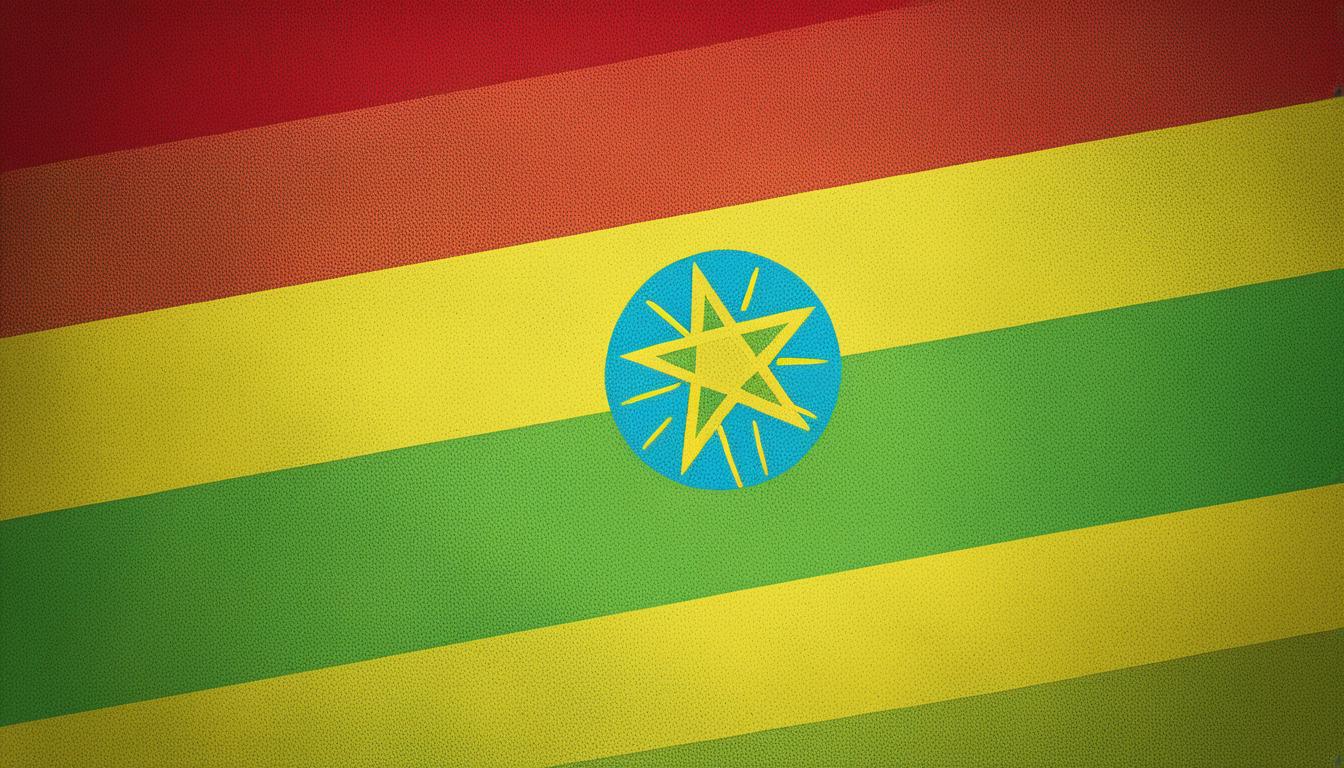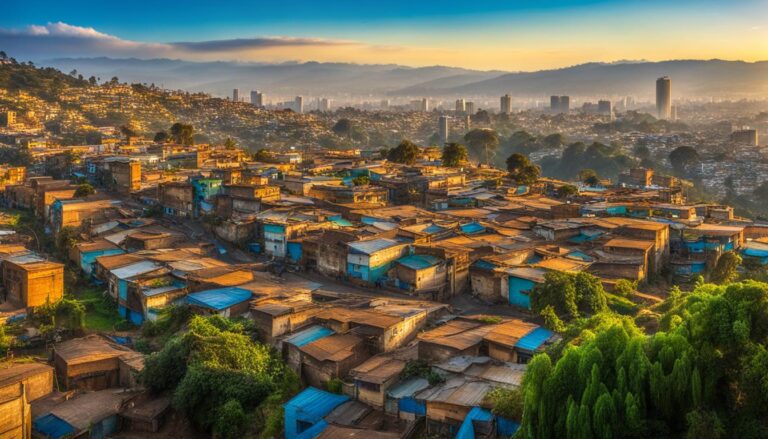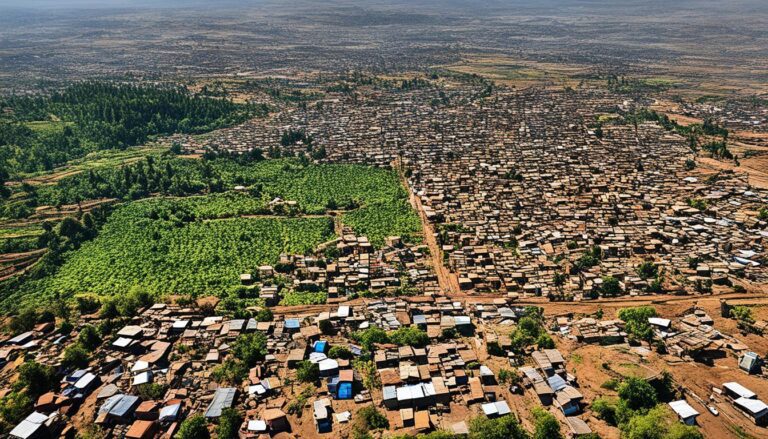Is Ethiopia 7 Years Behind?
Did you know that Ethiopia follows its own calendar, known as the Ge’ez Calendar, which is 7 to 8 years behind the rest of the world? This time difference has led to the saying that Ethiopia is 7 years behind in development. But is it just a matter of time, or are there deeper factors at play?
While the Ethiopian Calendar may contribute to a perceived lag in Ethiopia’s progress, it is essential to explore the complexities of this issue. Ethiopia’s development gap extends beyond its unique timekeeping system, encompassing a range of economic, societal, and historical factors that have shaped the country’s trajectory.
Key Takeaways:
- Ethiopia follows the Ge’ez Calendar, which is 7 to 8 years behind the Gregorian calendar.
- The Ethiopian Calendar has 12 months of 30 days each, with an additional 5 or 6 days at the end of the year.
- While the time difference is intriguing, Ethiopia’s development gap is influenced by various factors beyond the calendar.
- Ethiopia has made significant strides in economic growth and modernization but still faces challenges in poverty reduction, education, and healthcare.
- Understanding the complexities of Ethiopia’s development journey is crucial in appreciating its unique position in the global community.
The Ethiopian Calendar
The Ethiopian Calendar, also known as the Ge’ez Calendar, is a fascinating timekeeping system that sets Ethiopia apart from the rest of the world. Rooted in the ancient Coptic Calendar, it has unique characteristics that make it stand out.
The Ethiopian Calendar consists of 12 months, each containing 30 days. In addition, there are 5 or 6 extra days at the end of the year, depending on whether it is a leap year or not. These additional days help align the Ethiopian Calendar with the solar cycle.
One intriguing aspect of the Ethiopian Calendar is the time difference it presents. The calendar is 7 to 8 years behind the commonly used Gregorian calendar. This disparity in dates has led to the saying that Ethiopia is 7 years behind the rest of the world.
The Ethiopian New Year, known as Enkutatash, is a significant celebration in Ethiopia. It falls on September 11th according to the Gregorian calendar, or September 12th on leap years. This day marks the beginning of the new year in Ethiopia.
To help you visualize the Ethiopian Calendar and its unique structure, here’s a table highlighting its months:
| Month | Ge’ez Name |
|---|---|
| 1 | Meskerem |
| 2 | Tikimt |
| 3 | Hidar |
| 4 | Tahsas |
| 5 | Tir |
| 6 | Yekatit |
| 7 | Megabit |
| 8 | Miazia |
| 9 | Ginbot |
| 10 | Sene |
| 11 | Hamle |
| 12 | Nehase |
The Ethiopian Calendar is a testament to the rich culture and history of Ethiopia. It not only serves as a means of timekeeping but also reflects the country’s distinct identity and traditions. Understanding the Ethiopian Calendar provides us with a glimpse into the unique aspects of Ethiopian culture and its rich tapestry of celebrations and milestones.
Comparison with the Gregorian Calendar

The Ethiopian calendar and the Gregorian calendar have several differences, including the way they measure time and handle leap years. While the Gregorian calendar follows a 365-day year with an additional day added to leap years, the Ethiopian calendar follows a 365-day year with an extra 6th epagomenal day added every four years. This means that the start of the Ethiopian calendar year varies in relation to the Gregorian calendar.
To better understand the difference, let’s take a closer look at the Ethiopian calendar year and how it corresponds to the Gregorian calendar.
| Ethiopian Calendar Year | Gregorian Calendar Year |
|---|---|
| 2000 | 2007 |
| 2001 | 2008 |
As seen in the table above, the Ethiopian year 2000 corresponds to the Gregorian year 2007, and the Ethiopian year 2001 corresponds to the Gregorian year 2008. This time difference between the two calendars can lead to confusion when trying to align dates and events.
While the Ethiopian calendar may be different from the Gregorian calendar, it holds significant cultural and historical significance for the Ethiopian people. Understanding and respecting these differences can help foster a deeper appreciation for Ethiopia’s unique traditions and heritage.
Unique Aspects of Ethiopian Timekeeping

Ethiopia’s calendar system and timekeeping practices have distinct features that set them apart from the rest of the world. This uniqueness is attributed to the country’s adherence to the Ethiopian Orthodox Church and its traditions.
One of the notable differences is the celebration of holidays on different dates compared to other countries. For example, Ethiopians observe Christmas, known as Genna in the Ethiopian Orthodox Church, on January 7th or 8th according to the Gregorian calendar. This difference arises from the variation between the Ethiopian calendar and the widely used Gregorian calendar.
| Holiday | Date (Gregorian Calendar) |
|---|---|
| Genna (Christmas) | January 7th or 8th |
| Timkat (Epiphany) | January 19th or 20th |
Ethiopian Orthodox Christians also observe numerous fasting periods throughout the year. These fasting periods, totaling approximately 200-250 days annually, are an integral part of the Ethiopian Orthodox Church’s religious practices. During these fasting periods, individuals abstain from consuming animal products, including meat, dairy, and eggs.
These unique aspects of Ethiopian timekeeping and religious practices highlight the rich cultural heritage and deep-rooted traditions of the Ethiopian people.
Development and Modernization in Ethiopia
While the time difference between the Ethiopian and Gregorian calendars may indicate a lag in development, it does not necessarily reflect the current state of Ethiopia’s progress. Ethiopia has made significant strides in economic growth and modernization in recent years, with improvements in infrastructure, agriculture, and energy sectors.
One of the key drivers of Ethiopian development has been the focus on improving infrastructure. The government has undertaken numerous projects to enhance transportation networks, including road and railway systems, which have helped connect rural areas to urban centers. This has facilitated trade and investment, contributing to economic growth.
“Ethiopia’s commitment to modernize its agricultural sector has also played a crucial role in its development. Through initiatives like the Growth and Transformation Plan, the country has adopted modern farming techniques, improved irrigation systems, and invested in research and development. These efforts have boosted agricultural productivity and food security,”
Furthermore, Ethiopia has prioritized the development of its energy sector. The country has embarked on large-scale projects to increase electricity production, including the construction of hydroelectric dams. This has reduced dependency on fossil fuels and provided more households and businesses with access to reliable electricity.
Despite these advancements, Ethiopia still faces various challenges in its development journey. Poverty reduction remains a pressing issue, with a large percentage of the population living below the poverty line. Access to quality education and healthcare is another area that requires attention, as there are disparities in terms of availability and affordability.
Addressing these challenges requires a comprehensive approach, involving targeted policies and strategic investments. The government has recognized the need to foster inclusive growth and improve the wellbeing of its people, as reflected in its recent development plans.
Efforts to Enhance Entrepreneurship and Innovation
Recognizing the crucial role of entrepreneurship and innovation in driving economic growth, Ethiopia has placed a renewed focus on fostering a conducive environment for businesses to thrive. The government has implemented reforms to streamline business registration processes, enhance access to finance, and promote entrepreneurship education.
The Ethiopian government has also established innovation hubs and technology parks to support startups and encourage collaboration between academia, industry, and government. These initiatives aim to cultivate a culture of innovation and facilitate the development of high-value industries.
Furthermore, the government has sought to attract foreign direct investment (FDI) by offering incentives and creating special economic zones. This has led to increased investment in sectors such as manufacturing, agribusiness, and renewable energy.
The Role of Sustainable Development in Ethiopia
Ethiopia has embraced sustainable development as a guiding principle for its development agenda. The country has made significant progress in environmental conservation and renewable energy. It has implemented strategies to combat deforestation, promote sustainable agriculture practices, and mitigate the effects of climate change.
The government has also prioritized social development, aiming to improve access to basic services and reduce inequality. Efforts have been made to enhance healthcare services, strengthen social protection programs, and promote gender equality.
In conclusion, Ethiopia has made remarkable strides in development and modernization, with significant advancements in infrastructure, agriculture, and energy sectors. Challenges in poverty reduction, education, and healthcare persist, but the government’s commitment to inclusive growth and sustainable development provides a foundation for continued progress. Ethiopia’s journey towards comprehensive development involves fostering entrepreneurship and innovation, as well as prioritizing social and environmental sustainability.
Factors Influencing Ethiopia’s Development Gap
The development gap between Ethiopia and other countries can be attributed to various factors. Historical contexts, including colonization and conflicts, have influenced Ethiopia’s path to development. Political stability has also played a role, with periods of political unrest impacting progress. Additionally, Ethiopia faces geographical challenges, such as landlocked borders and a predominantly agrarian economy, which can affect its ability to compete in a globalized world.
“The historical context of Ethiopia has shaped its development trajectory. Colonization and conflicts have had a significant impact on the country’s progress. However, against all odds, Ethiopia has shown resilience and determination to overcome these challenges.” – Ethiopian historian
Ethiopia’s rich historical background has shaped its development journey. The country experienced colonization by Italy in the late 19th century and early 20th century, which had detrimental effects on its economy and infrastructure. Furthermore, conflicts, such as the Ethiopian Civil War, further hindered progress. These historical factors have contributed to Ethiopia’s development gap compared to other nations.
The political stability of a nation plays a crucial role in its development. Ethiopia has faced periods of political unrest throughout its history, including the overthrow of Emperor Haile Selassie in 1974 and the Marxist-Leninist Derg regime that followed. Such political upheavals can disrupt economic growth and create an uncertain environment for investors. Despite these challenges, Ethiopia has made significant strides in recent years towards establishing political stability and attracting foreign investments.
“Ethiopia’s political stability is essential for its development. It is encouraging to witness the positive steps taken by the Ethiopian government to ensure peace and stability in the country.” – International political analyst
The geographical challenges faced by Ethiopia also impact its development. The country is landlocked, which limits its access to international trade routes and increases transportation costs. Additionally, Ethiopia’s economy has traditionally been dependent on agriculture, with limited industrial diversification. Such factors can pose obstacles to economic growth and make it difficult for Ethiopia to compete with countries that have more favorable geographical positions.
Ethiopia’s geographical challenges highlight the importance of investing in infrastructure, diversifying the economy, and exploring new trade partnerships. By addressing these factors, Ethiopia can bridge the development gap and position itself as a competitive player in the global arena.
Ethiopian Historical Context
Ethiopia’s historical context has significantly influenced its development. From colonization to internal conflicts, the country has faced various challenges that have shaped its development trajectory. However, Ethiopia’s rich cultural heritage and resilience have contributed to its progress.
Ethiopian Political Stability
The establishment of political stability is vital for Ethiopia’s development. Periods of political unrest can disrupt economic growth and deter foreign investments. Ethiopia has made strides in promoting peace and stability, paving the way for further development.
Ethiopian Geographical Challenges
Ethiopia’s geographical challenges, such as being landlocked and having a predominantly agrarian economy, pose obstacles to its development. However, investments in infrastructure and diversification can help overcome these challenges and drive economic growth.
Conclusion
Ethiopia’s unique calendar system, which is 7 years behind the Gregorian calendar, is just one aspect of the country’s rich cultural heritage. While the saying “is Ethiopia 7 years behind” may hold true in terms of calendar alignment, it is important to consider Ethiopia’s progress and development within its own context.
The country has shown significant growth in various sectors, such as infrastructure, agriculture, and energy, indicating Ethiopia’s progress in modernization. However, Ethiopia still faces challenges in achieving comprehensive development. These challenges include poverty reduction, education, and healthcare, where efforts are needed to improve the overall well-being of its people.
Understanding the complexities of Ethiopia’s development journey is crucial in appreciating its unique position in the global community. Despite facing hurdles along the way, Ethiopia continues to strive for progress and is actively working towards overcoming its development challenges to build a brighter future for its people.







